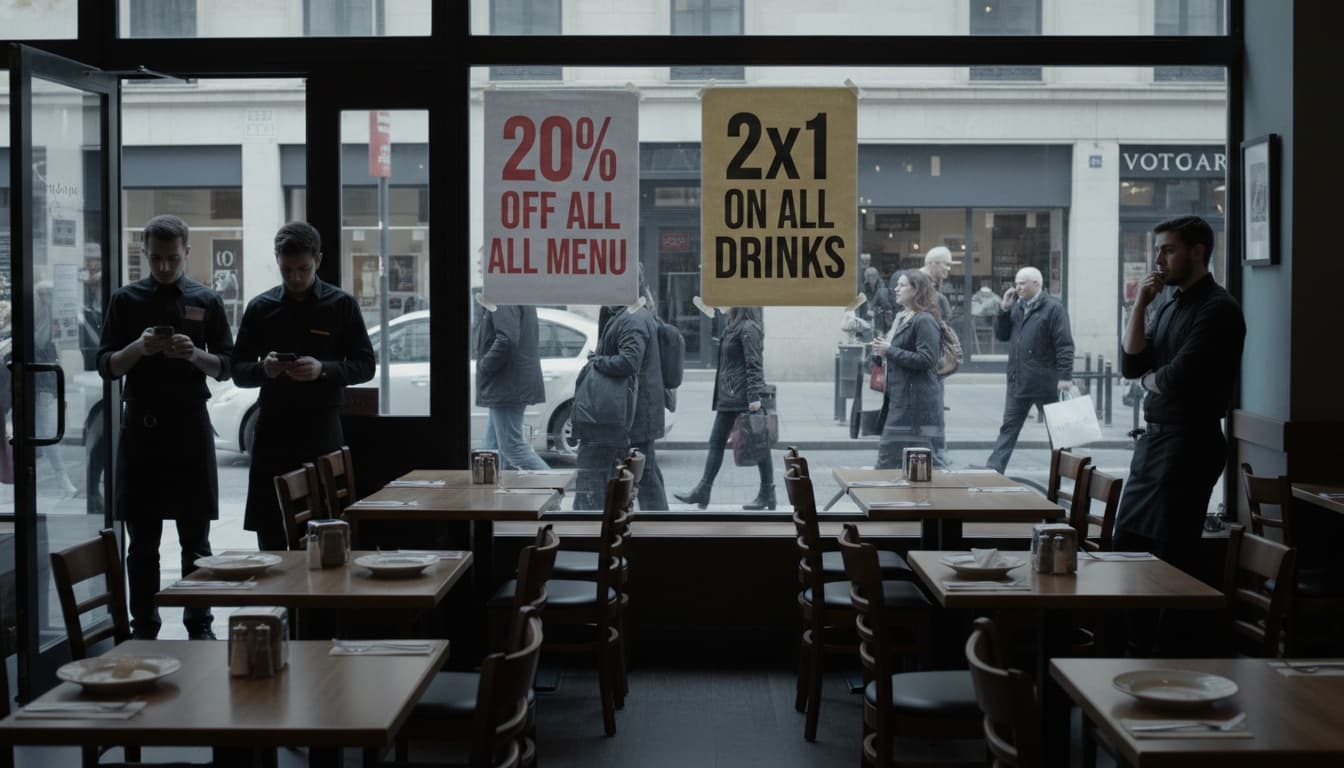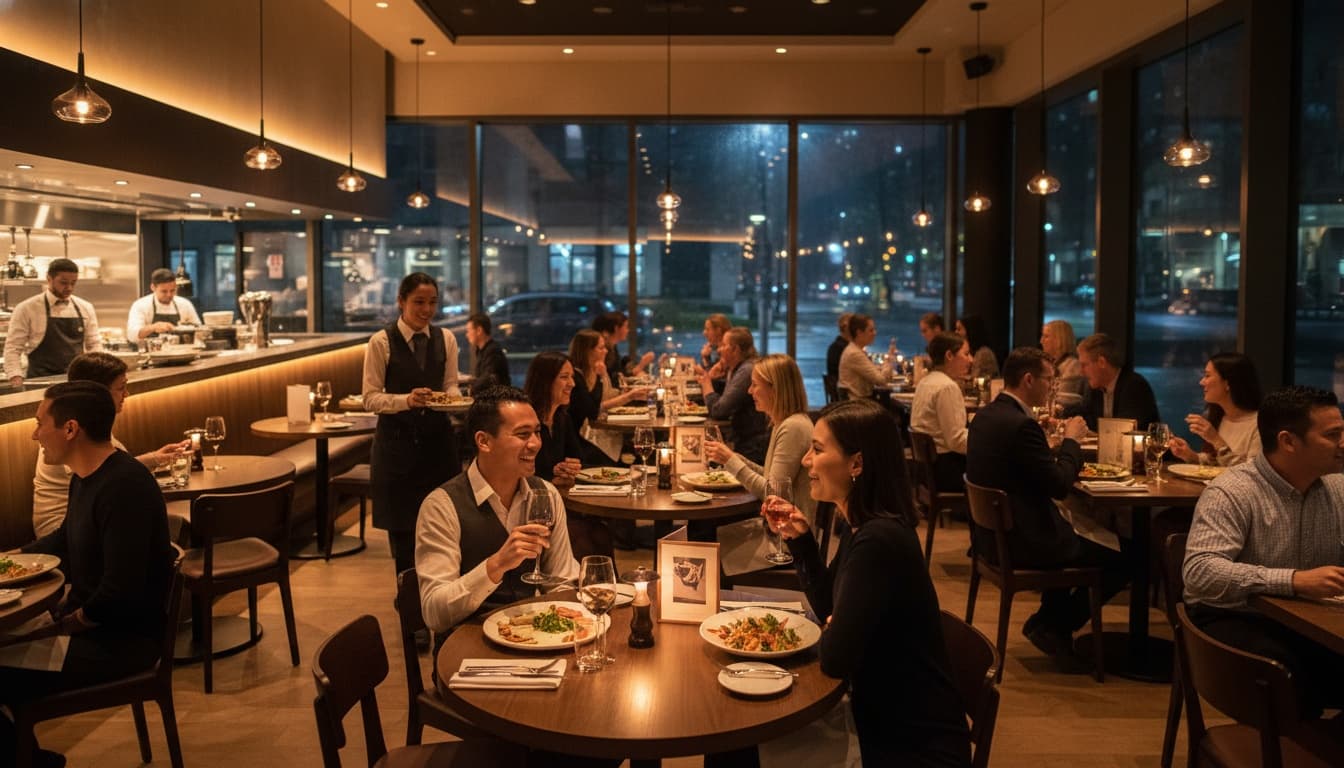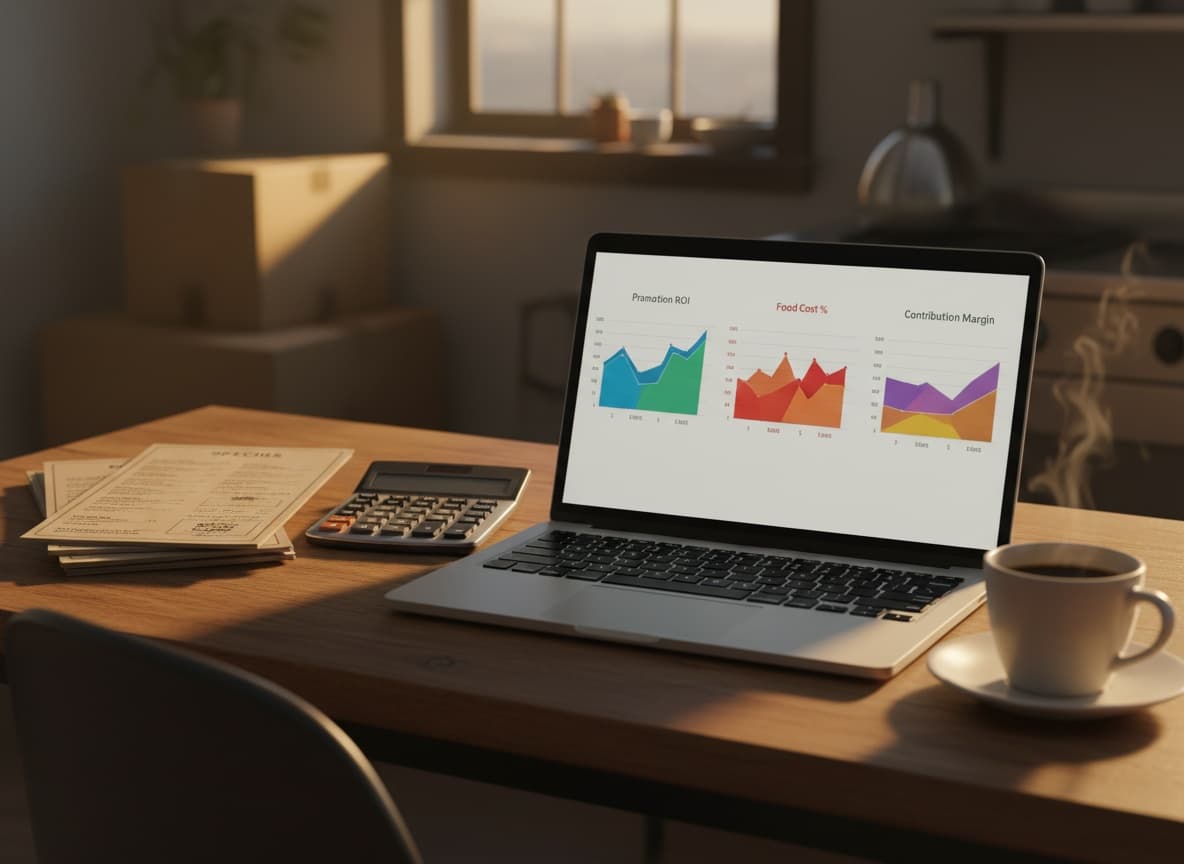Restaurant promotions are one of the most misunderstood tools in the industry. While many campaigns fill seats in the short term, a large portion either break even or lose money once discount depth, food cost, and guest behavior are fully accounted for. With net profit margins often sitting in the 3–7% range and food costs between 28–35%, restaurants cannot afford to run promotions that only attract deal-seekers and erode pricing power.
The math is unforgiving. A 20% discount on a menu item with a 65% gross margin does not reduce profit by 20%—it can force you to sell 40–50% more volume just to maintain the same gross profit dollars. When you combine this economic reality with behavioral psychology—scarcity, social proof, reward anticipation, and commitment—you start to see why some promotions consistently drive profitable traffic while others quietly destroy value.
Why Most Restaurant Promotions Don’t Work

Most restaurant promotions fail for the same structural reasons: they overuse blanket discounts, ignore segmentation, and are almost never measured properly. The result is more complexity, lower margins, and guests who only show up when there is a deal.
The discount dependency trap
Blanket percentage discounts like “20% off everything” feel simple and powerful, but they train guests to wait for sales and anchor their perception of your prices at the discounted level. Over time, restaurants increase the discount depth and frequency to maintain results, until most of the year is effectively on sale. These campaigns disproportionately attract highly price-sensitive guests with low loyalty and low lifetime value.
Strategic segmentation failures
Families, business diners, tourists, and date-night couples respond to completely different triggers. A family of four on a budget is thinking about total ticket and convenience; a corporate guest cares about speed, reliability, and the ability to expense the meal; an experiential diner is optimizing for novelty and status. One generic promotion trying to speak to everyone usually resonates deeply with no one. Targeted offers, by contrast, consistently achieve much higher response rates and better unit economics.
Measurement and follow-up gaps
Many restaurants call a promotion a “success” simply because traffic increased on that specific day. Without a baseline and without tracking post-promo behavior, that is an illusion. You need to know: what portion of that traffic was incremental, how much margin remained after the discount, how many customers were new vs. returning, and how many came back in the next 30–60 days. Without these numbers, it is impossible to tell whether the promotion created growth or just shifted demand into a single date.
Psychology Behind High-Performing Restaurant Promotions

Promotions work when they fit the way people actually make decisions: fast, using mental shortcuts and a strong emotional component. Instead of thinking only in terms of “coupons,” think in terms of triggers: scarcity, social proof, consistency, peak-and-end memory, and price anchoring.
Scarcity and urgency mechanisms
Scarcity activates loss aversion: “if I don’t go now, I’ll miss something.” It works best when it is real and credible: a seasonal menu for one week, a limited ingredient, a maximum capacity for a specific event. Messages like “this weekend only” or “only 40 seats per night” accelerate decisions and reduce procrastination.
Social proof and community validation
When people see that “others like them” have already chosen a place, perceived risk drops. This can appear as a busy dining room, tagged stories, positive reviews, or customer photos highlighting a specific promotion. Connecting promotions to user-generated content (UGC) amplifies impact without increasing media spend.
Commitment and consistency
Once someone commits to a step (making a reservation, signing up, joining an event), the natural tendency is to stay consistent with that decision. Loyalty programs, reservations tied to special menus, and recurring series (like monthly “tasting nights”) all lean on this principle: each interaction reinforces the internal story of “I am a customer of this place.”
Peak-end rule and memory formation
People don’t remember the average of an experience; they remember its emotional peak and its ending. Well-designed promotions create a clear peak (a surprise, upgrade, or special moment) and a strong ending (personalized thank you, invite to the next event, a small future benefit). This edited memory is what actually determines whether they come back.
Anchoring and price perception
Putting a reference price before the offer completely changes perceived value. Showing a “tasting menu at $95” next to a “chef’s table at $165” anchors the second as premium and the first as “a great deal,” even if it is expensive. In promotions, always present the full price before the promotional price to maximize the feeling of gain.
Promotions That Actually Drive Traffic

Effective promotions are not magic; they are combinatorial. They combine the right psychology, healthy offer mechanics, and smart timing. Below are formats that typically generate incremental traffic without compromising financial health.
Low-cost, high-impact incentives
Free appetizer programs with minimum spend
“Get a free appetizer when you spend at least $X” is far healthier than “20% off the entire bill.” You anchor value on the word “free” but condition the benefit on a minimum ticket that pushes spend higher. Choose appetizers with high perceived value and relatively low cost, such as more elaborate preparations with solid food-cost ratios.
Weekday traffic optimization
Monday to Thursday usually come with spare capacity. That’s where it makes sense to concentrate most promotions: “Pasta Tuesday,” “Wine Wednesday,” “Tasting Thursday,” and similar concepts. Even with slightly lower margins on those days, you cover fixed costs, turn inventory, and build habits. The key is to shield Friday and Saturday from aggressive discounts to preserve top-margin periods.
Family bundles and shared menus
Family bundles reduce decision friction (“what is everyone going to order?”), deliver a strong sense of value, and create cost predictability for both the guest and the kitchen. Work with a single price for three to four people, with solid contribution margin and portion structures that make execution easier. The shared experience tends to generate high satisfaction and strong recommendations.
Seasonal and limited-time offers
Seasonal offers tap into real scarcity (ingredient, season, specific time window) and give guests a concrete reason to visit again: “go back before it’s gone.” They also serve as a lab: what performs well can become part of the core menu; what doesn’t fit can return occasionally as a limited special.
Experience-based promotions
Events like chef’s tables, wine-pairing dinners, themed nights, or tasting menus create something guests cannot reproduce at home. The focus is not on discounting; it is on value: direct access to the chef, storytelling, behind-the-scenes moments, pairings, and small surprises throughout the evening. These experiences usually deliver higher average tickets and better margins than standard service.
Digital-first promotions
SMS campaigns, push notifications, QR codes, and social media promotions enable fine-grained segmentation and near real-time triggers. A well-targeted SMS to an opt-in base often sees open rates above 90% and strong conversion when the benefit is clear and the deadline is short. Table QR codes leading to digital scratch cards, spin-to-win wheels, or giveaways let you capture data and gamify return visits.
How to Use Promotions Without Killing Margins

A good promotion is one that increases contribution margin over the relevant period, not just gross revenue. That requires looking beyond food cost and including staff effort, media spend, and any cannibalization of full-price sales.
Understanding true promotional economics
A simple model considers: food cost, extra labor cost, media cost per redemption, and opportunity cost (whether the promo table is taking the place of a full-price guest). Only after adding all of that together does it make sense to compare against the incremental revenue generated.
Threshold offer optimization
“Get X when you spend at least Y” offers are much more predictable. Choosing the right Y depends on your current check distribution. Typically, you want a threshold slightly above your current average ticket, pulling spend up while remaining attainable for most guests. The logic is: part of the reward is paid for by the higher ticket; the rest is an investment in loyalty.
Time-based strategic positioning
Positioning promotions at the right times and days lets you use idle capacity as leverage. A strong happy hour with bundles during the quietest part of the afternoon can be excellent business—provided you don’t destroy margins in the time slots where you would already be full without any special deals.
Building Repeat-Visit Loops Through Promotions
Promotions should not be one-off shots; they should be the beginning (or reinforcement) of a recurrence loop. Each campaign is an opportunity to capture data, improve segmentation, and guide the guest toward a next planned visit.
Systematic customer journey integration
The basic blueprint for a healthy loop is: promotion → visit → data capture → thank-you and feedback → value-driven content → new segmented offer. Instead of a random “discount flyer,” you build a funnel where each step increases context and trust.
Data capture and personalization
Every time someone interacts with a promotion, you have a chance to learn something: email, phone number, dish preferences, booking channel, occasion (birthday, family, business). That data powers future communications and enables more personalized experiences, like remembering a special date or suggesting something aligned with past orders.
Smart customer segmentation
Not everyone should receive the same message. New customers need extra social proof and a strong reason to make a second visit. Occasional guests respond better to incentives that increase frequency. Regulars value recognition and VIP treatment. High-lifetime-value customers deserve exclusive experiences, not just discounts.
Common Promotional Mistakes and Solutions
Some mistakes show up in almost every restaurant that has “tried everything” and concluded that promotions don’t work. In practice, the problem lies in the mechanics and in the lack of a system.
Measurement system failures
Without measurement, every promotion looks better than it really is. Solving this means defining metrics upfront: redemption rate, average check with and without the promotion, number of new customers, 30–60 day return behavior, total cost as a percentage of attributed revenue. With this data, you move from guesswork to real optimization.
Overcomplication and clarity issues
Promotions that nobody understands don’t perform. A simple rule: if the team cannot explain it in one sentence, it is too complex. Simple mechanics, clear rewards, and an easy redemption path create more usage, less frustration, and less friction on the floor.
Discount dependency and brand erosion
Discount dependency is born when the brand fails to communicate value beyond price. The way out is to rebalance the mix: less emphasis on percentage discounts and more on special experiences, member-only perks, early access to menus, and behind-the-scenes content that reinforces quality.
Ignoring post-promotional behavior
The real test of a promotion is not traffic on the campaign day—it is guest behavior in the following 90 days. If customers never return or only show up for the next aggressive offer, you are training promotion hunters, not building a loyal base. Segmenting and tracking this group is essential to decide what to repeat, adjust, or abandon.
Strategic Implementation Framework
For promotions to become a strategic lever rather than a tactical patch, you need a calendar, operational integration, and clear review cycles.
90-day promotional calendar development
Work with a 90-day view that combines major campaigns (LTOs, events), supporting actions (loyalty program pushes, bundles, return triggers), and tactical moves (flash sales, weather-based offers, local event tie-ins). This reduces panic decisions and helps the team prepare in advance.
Operational integration requirements
No promotion survives first contact with a disorganized kitchen. Before launching, make sure you have: team training, planned inventory, POS configurations done, aligned communication materials, and a clear process for solving issues if something goes wrong (item stockout, system failure, billing errors).
Performance optimization cycles
Scheduling analysis routines prevents you from repeating expensive mistakes. Weekly reviews help adjust execution; monthly reviews focus on ROI and guest behavior; quarterly reviews reshape the calendar. This is how you turn learning into competitive advantage.
Long-term strategic positioning
In the long run, your promotions should reinforce—not dilute—your brand positioning. Restaurants that use psychology plus numbers in their favor can turn campaigns into a predictable engine for traffic, frequency, and average check, while competitors keep burning margin on generic discounts without understanding why.
Turn every promotion into a measurable growth loop
VISU helps restaurants connect QR codes, campaigns and rewards into one smart system. You capture data from every promotion, reward the right guests, and see exactly which offers drive profitable traffic instead of random discount spikes.

